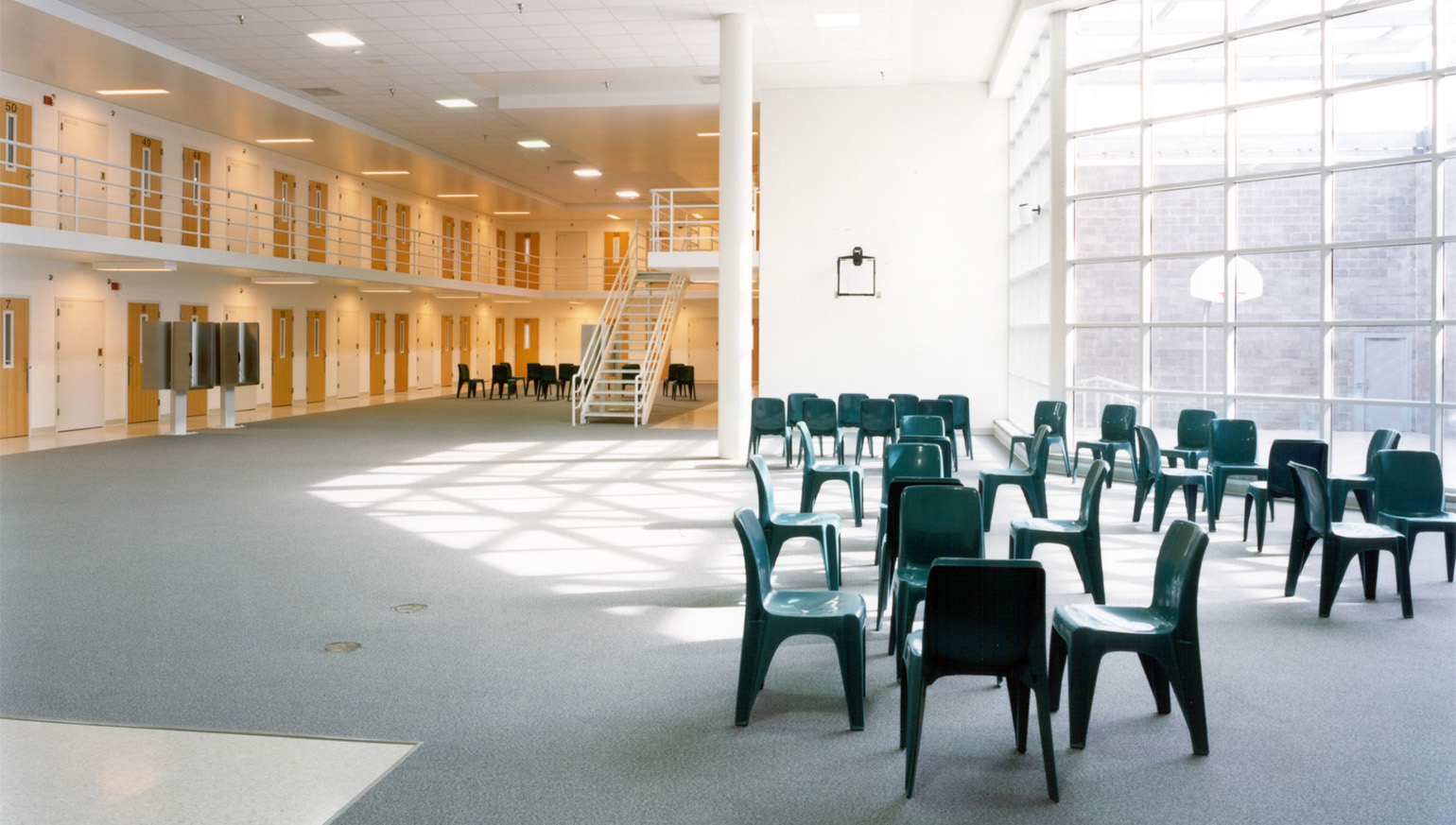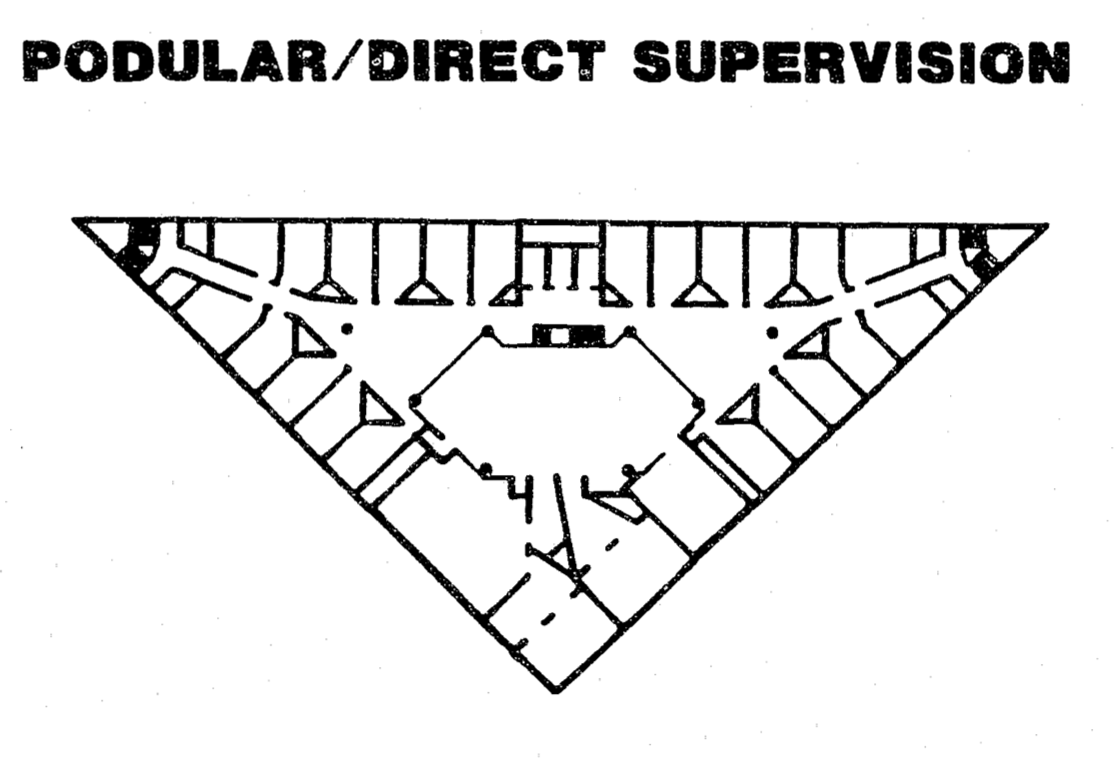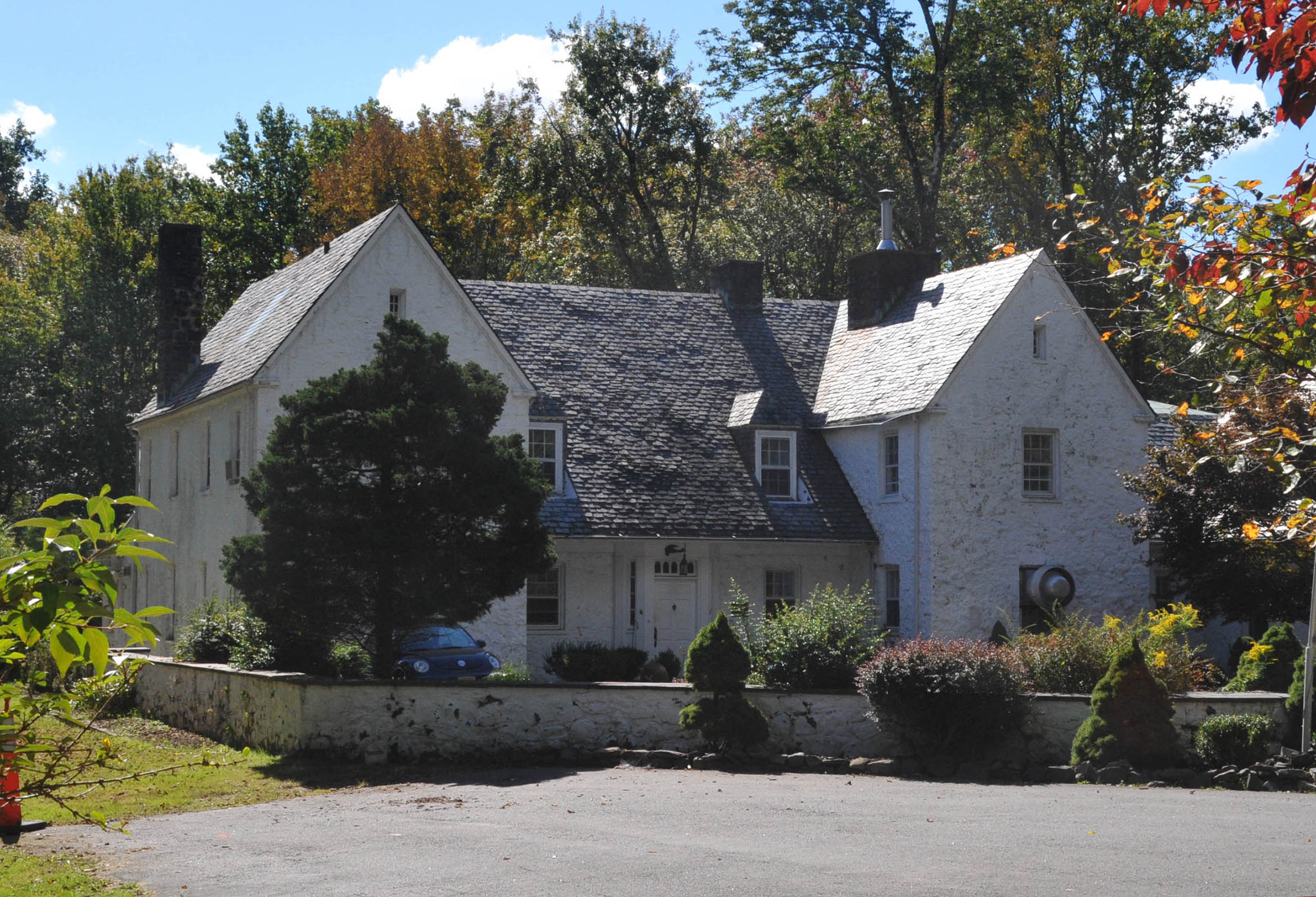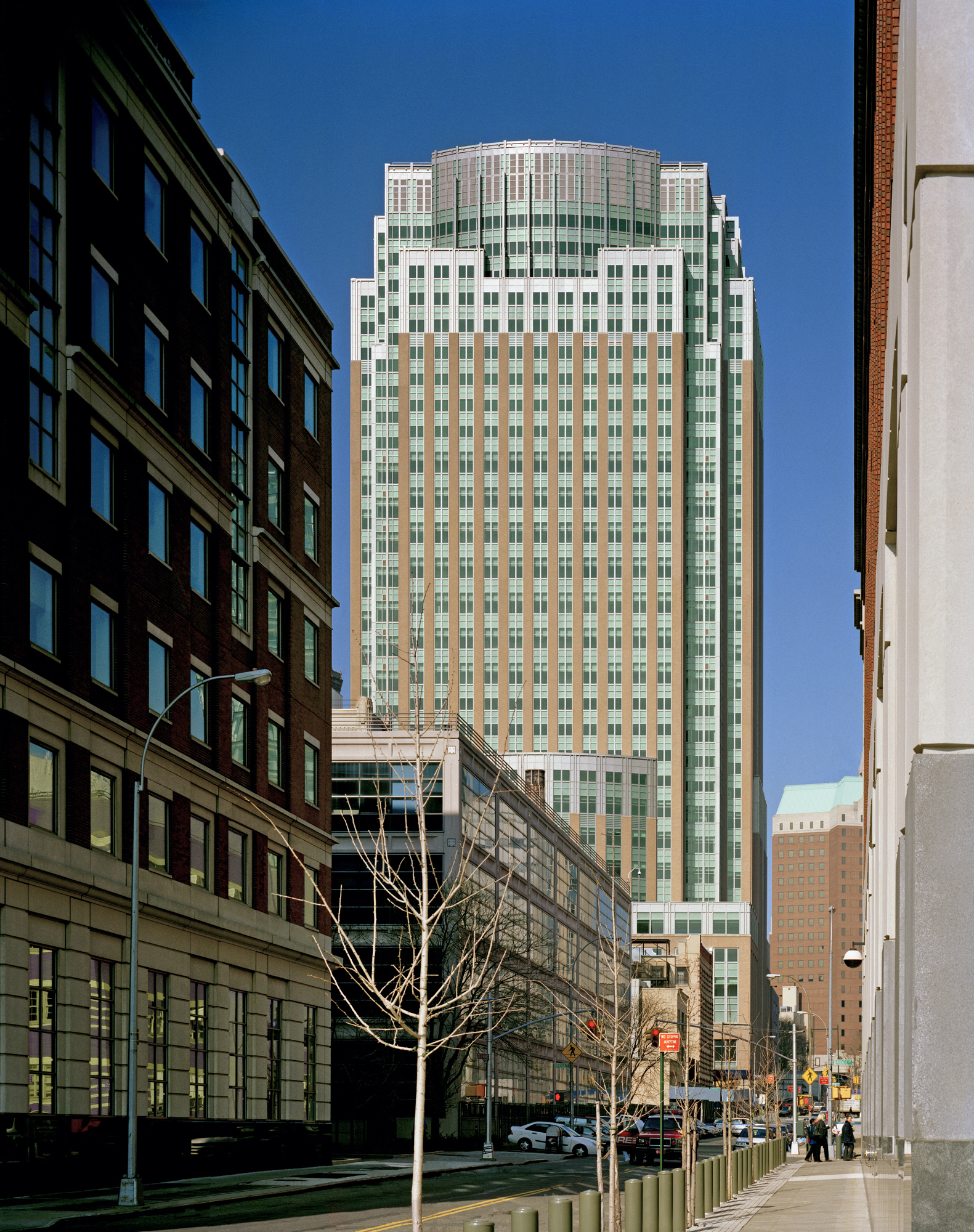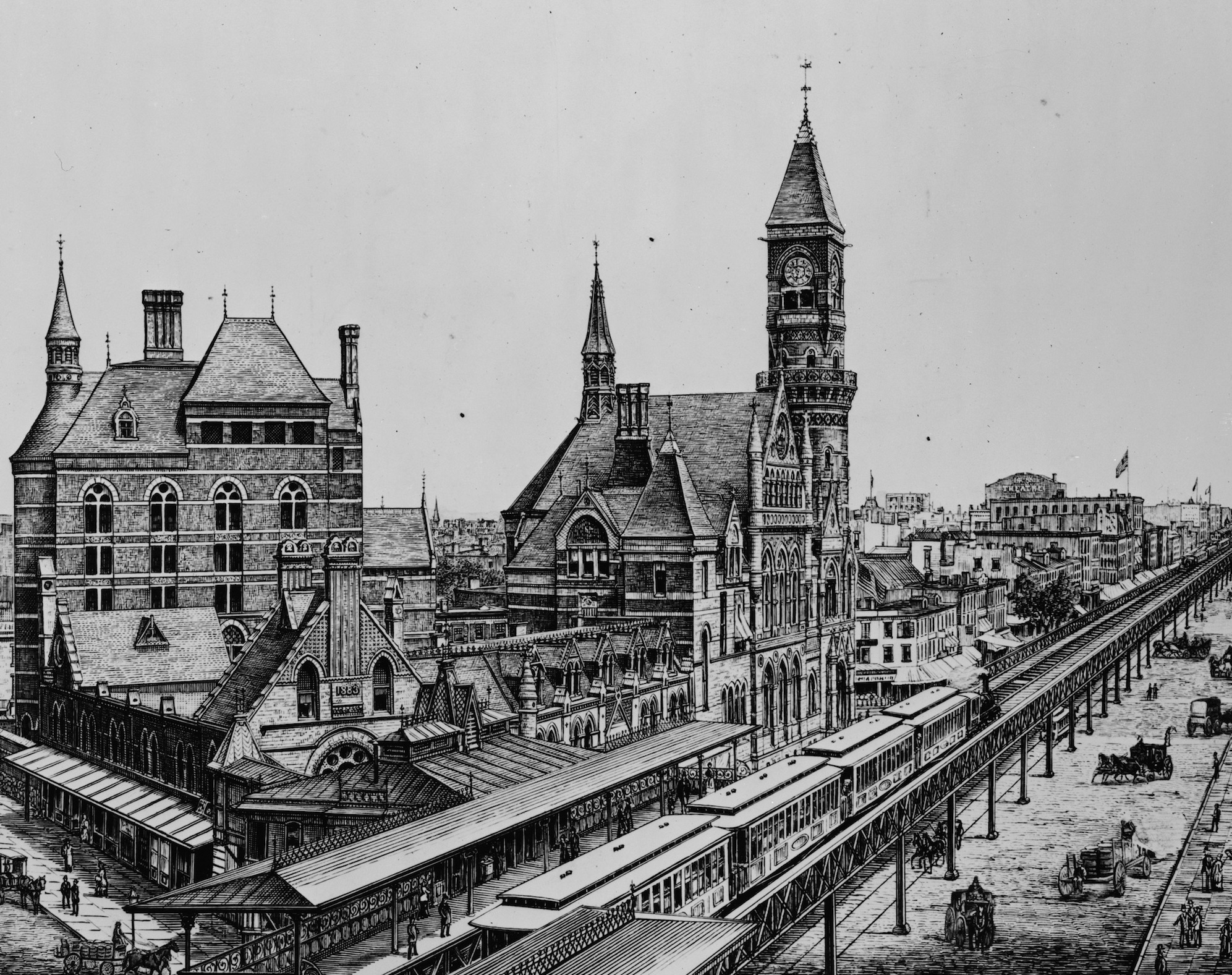The Location of Justice
An examination of the pervasive and often overlooked infrastructure of criminal justice in New York and the spaces that could serve a more just city.
In This SeriesWe are celebrating 15 years — and counting — of stories that are deeply researched and deeply felt, that build a historical record of what the city has been.
Like hospitals, stadia, and shopping malls, the structures of the criminal justice system demand complex spatial considerations, and architects specialized in meeting them. But with individual lives and liberties in the balance, buildings like courts and jails inspire ethical questions and social consequences beyond the scope of other public structures. Frank Greene and Kenneth Ricci, principals of New York based RicciGreene Associates, provide architectural and planning services for courts, jails, and juvenile detention facilities in the region and across the nation. Over five decades in the practice of justice architecture, they have witnessed a succession of approaches to corrections and detention, from rehabilitation to punitive mass incarceration, and back to rehabilitation. While some of today’s best practices are nothing new, signs of growing support for smaller-scale, local, and more humane approaches to incarceration today are encouraging. Below, Greene and Ricci talk about the roles courts and jails play — and should play — in the criminal justice system and in how cities and counties address pressing social problems. And they outline their role as justice architects, not only in designing environments to cue desired behavior, but using planning tools to change the minds and actions of clients who want to build more and bigger jails.
How did you find your way to justice architecture?
I did my thesis at Pratt on a youth correctional facility on Rikers Island. That was during the ‘60s; we felt that architecture should have a social dimension. This appealed to me because it had technological and sociological implications.
I did a project in Boston installing a second shower at the Deer Island Correctional Facility. 175 men only had one shower, so a federal judge had ordered them to improve conditions by installing a second shower head. Another project I did at that time was to help to suicide-proof the jail cells in the police stations by removing points where people could hang themselves. It just struck me how poorly people that are arrested and incarcerated are served as they move through the system. Ken and I had a similar sense of purpose about dedicating our careers to the improvement of the experience of the justice system, for the people that work there, but also for the citizens and people that are drawn up and caught up into the system.
Since you started the practice in 1970, there has been a very big upswing in the number of people who have been incarcerated, and now we’re starting to see the numbers go down. Could you talk a little bit about what you’ve seen?
We’ve been through a number of eras in the corrections-detention field, starting in the ‘70s with the establishment of the constitutional rights of individuals in detention. That set the stage for improvements. Then in the ‘80s, we began to see overcrowding because of a lot of factors which we won’t get into here. The overcrowding introduced a whole new set of problems: no matter what was provided, it wasn’t sufficient to meet a humane standard for the numbers of people that were coming through. Then in the late ‘90s there came a realization that this field needed to be professionalized. There was movement in the professional organizations of correctional officers.
We got involved in the direct supervision movement, which said that the best way to supervise individuals in detention, except for those who are predatory, is to have the officer in the housing unit with the individuals. There was more of a window opening on more humane treatment, more humane design.
What is direct supervision?
There’s a housing unit with fifty to sixty detainees, and one officer circulating amongst those detainees. And it’s as normative as possible: You’re trying to create normal behaviors. The officer is able to monitor who’s saying what to whom and what’s going on. If you take that officer and you put them in a glass bubble, or even worse, if they’re just looking through a little window and they can’t fully hear what’s going on, they can’t see everything, then among the detainees it becomes a pyramid of who’s strongest, toughest, meanest, most connected. It’s dangerous to the weaker inmates and to the officers. Everybody’s behavior changes, everyone’s blood pressure goes up. The officers behave more aggressively, there’s more intimidation, rather than communication.
These housing units are larger than a cell block would be, in terms of square footage per inmate. But you have better sight lines, you can hear what’s going on, you can see outside. The inmates can go out to a recreation yard adjacent to it without lining up and traveling. Everything is brought to the inmates, even visitation and counseling. A lot of innovative physical design characteristics that implement the dual goal of meeting risk and need, but also lowering cost. And improving safety.
How does it lower cost?
What we do is less expensive to build than steel bars. We use normative materials. There’s sheet rock on the ceiling; that costs one-tenth of the cost of a secure ceiling. We know where to put the secure elements and where to put normative elements that absorb sound and provide a sense of texture. A jail we designed in Orange County, New York, has wood doors, with vision panels in them.
A big part of the cost of operating an indirect supervision jail is moving the detainees for all their services. You need the officer that’s on the housing unit, but you also need the transport officer, and you need someone in visitation. It takes a lot of staff time. I think there are some old-school systems, like right here in New York, where there are as many if not more officers as there are detainees. The cost is not in construction, the cost is in operation over time.
How have theories of justice and theories of incarceration affected your work?
We make a strong distinction between jails and prisons. Jails are pre-trial, prisons are post-adjudication. The community-based idea goes back quite a long time, to the 1948 Highfields House in New Jersey; it comes and goes. When I started in juvenile detention design, we designed a 24-bed community correctional center, here in Chelsea for the New York State Division for Youth. There’s a good theoretical underpinning for it, and I think you’re seeing a resurgence of that idea in the discussion around depopulating Rikers Island.
Our firm, CGL, has 15 planners as well as 25 or 30 architects. We’ve had a systems-based philosophy from the beginning: you cannot look at the building absent the entire system. We began to develop techniques to answer the question: “How big should my new jail be?” We would say to clients: “Don’t ask how big your new jails should be. Ask, how small can it be to do the job it’s supposed to do, and what other mechanisms can the system implement to reduce the number of people flowing into your jail?” The jail is a captive of the justice system. If there’s a lot of policing and a lot of arrests, that affects the jail. If the courts delay, that affects the number of people in jail. If the district attorney files charges in a certain way, or only holds grand juries once a month, that affects the number of people in jail. The clients would say to us, “Why do you want to make our jail smaller? We assume you make more fee if the jail is bigger.” Our response was, “You can’t afford to build your way out of jail overcrowding. We’ll show you how you can make your jail smaller, smarter, and greener and kinder. But it also requires cooperation from the justice system actors around you. Courts, probation, police, the DA, and so on.”
Over the years, we’ve built a reputation for the design response as well. We believe that environment cues behavior, and in order to get proper behavior inside the jail — after all, we want to keep everyone safe — there are a number of design dimensions that you can implement. Excellent sight lines, excellent movement, introduction of natural light into the facility, views to the outside. And it’s worked. Clients have said, “When I come to work in this facility, I don’t go home with a headache.”
Detention should be treated as a scarce resource, not a one-size-fits-all remedy for anyone that’s arrested. And alternatives to incarceration and alternatives to the process itself should be used wherever possible to reduce the harm and trauma that happens to people in the system. At a certain point that perspective was counter to the national trends, to incarcerate, incarcerate, incarcerate. If you lock people up, the judge can’t be blamed, the police can’t be blamed. If you take a risk and let people out or try to work with people, there’s a risk that they might reoffend.
There was a dichotomy set up in the ‘70s between “rehabilitation” and “recidivism,” and any instance of recidivism then negated the whole idea of rehabilitation. Those words both had great power. If you talk to any of the practitioners in the field today, they’re talking about improved outcomes, that the minute the person comes to a jail, or a prison, there’s a plan made for their release, and everything that happens while they’re in the institution is about them returning to society, hopefully not more deeply traumatized than when they showed up and better prepared to succeed. So the posture of the justice system has shifted dramatically in my career. It’s very encouraging. I’d love to see it take root here in New York City, which in many ways has been behind.
New Yorkers think of themselves as leaders and innovators. Police in New York have been national leaders in smarter policing. Through the Center for Court Innovation, the court system in New York City has been a national and international leader in best practices. But the Department of Corrections has conspicuously lagged behind. It’s the opinion of the National Institute of Corrections and many others that the culture at Rikers Island has not adopted best practices and more effective, less costly treatment of detainees and prisoners. It’s also been true of the state prison system, I think. The Lippmann Commission’s report, and its adoption by the Governor and the Mayor will mean that finally our corrections system can at least get up to par with the rest of the country.
The Associate Commissioner of Corrections said at one point: “Take us into the 20th century.” And that was in the 21st century.
Who is your client, and what’s their impetus to take up this work?
The client are the county commissioners.
Or the Mayor of New York.
A lot of enlightened clients have set up criminal justice coordinating committees. We have one in New York City. The idea was novel thirty years ago, it’s now kind of standard. There’s no such thing as a criminal justice system, there’s no one actor that moves all the dials, there are separately elected individuals.
In almost every case, the impetus to start our activities is that the jail’s overcrowded. Or they’re paying rent to board people in other counties, and they don’t know what to do. “Should we build a 300-bed jail that we can put 200 people into and accommodate growth?” I guarantee, if you build a 300-bed jail, it will fill up, because it’s easy to park people there. What we’ve been able to do is look at the system. Look at the practices, look at the population: Who’s in there, on what charges, for what length of stay? What you measure you can improve, and that act itself, very often, can reduce jail populations just by improving the throughput. Most people that go to jail stay less than a week; a very large percentage stay less than three days. If you can have them released in two days instead of three days, or have them released in three days instead of seven, you’ve reduced the jail population right there.
One would think that people in the department of corrections or the criminal justice coordinator’s office would be gathering that data.
They’re actually stating the problem the wrong way. The problem is not that your jail is too small, your problem is your system is messed up. We started to notice it years ago: The younger detainees, in these rural areas, had major issues with homelessness, mental health, drug abuse, substance abuse. And no job.
We did a master confinement study for one county, and though they originally intended to build a 250-bed jail, they’re now going to build a 100-bed intake center with 100 cells for people that have been arrested, and a stabilization center for people that come in with recognizable mental health issues. The police are now being trained in something called CIT (Crisis Intervention Training) to recognize a schizophrenic break on the street. And when they put the person having a schizophrenic break in the patrol car and bring them to the facility, they don’t go into the secure part; they go into a stabilization center, where they can stay for 24 hours. They cannot be involuntarily admitted to a mental health facility, but mental health professionals in the center try to work with them to try to get them reconnected to their environment.
And they can be referred to community-based resources — people who can handle their needs in non-secure settings.
Or they can choose not to, and they walk out the front door. We have a sobering center as well. There’s a judge, who hears the cases. So you begin to see the pieces of the justice system — law enforcement, courts, probation, mental health, and corrections — come together under one roof. This is a new model, which we’re calling the three-door jail. You either go into detention, diversion (released on bail or on recognizance) or deflection into the mental-health system.
The mental health issues play a huge role in New York as well. Do you see them coming from the same complex of causes or is it a different situation in rural areas?
The mental health issue is a big issue in big counties, middle-sized counties, and small counties. Urban and rural. It doesn’t matter. I think the jail has become a catch-all for society’s problems. It’s a convenient way to put people out of sight.
What we’ve discovered over the years is that there aren’t any new ideas. It’s all a matter of execution. It’s a matter of policy. The Lippmann Commission was groundbreaking simply because finally there’s a political consensus about Rikers Island, which hasn’t existed before. Mayor Koch wanted to sell Rikers Island to the state. We did a whole planning study for that. Mayor Koch wanted to build jails in the boroughs. We studied all the jails in the boroughs. That was forty years ago. So this idea is not new, but it finally has political traction. As we like to say around here, this is a life’s work.
But the tide is going in the right direction. Everywhere you go in the country, it’s the same concerns. Mental health is key, but also trying to program better opportunities and better outcomes for all people who come in contact with the system.
Are the dollars following the policy intention?
Never enough. It’s hard for legislators to assign money to the unfortunates, and people would rather spend money on a new high school gymnasium or on computers in the classroom than they would be improving conditions for the incarcerated. It’s easier to get dollars for tough on crime policies than it is to get dollars for better jails, but that doesn’t mean you don’t try.
What do you think are the most important considerations for new community-based or local jails, in terms of perception of jails and willingness to have them in the neighborhoods?
Well, obviously NIMBY is a big issue. But something we’ve been preaching for a long time is that jails make good neighbors. Properly designed jails, like the redesign that we did of the Brooklyn Detention Center, improve property values around the neighborhood. Forest City Ratner, who builds more apartment buildings than just about everybody, says jails do not have an effect on property values.
Modern jails are sealed buildings. We use glazing, we don’t use steel bars, so you can design a building to be a legitimate civic building. You could drive by, you wouldn’t know it’s a jail. A lot of the jails we’re doing are downtown now, adjacent to the courts. And because of the modern materials, we’re able to make them look like an ordinary building that an ordinary person would not be afraid of.
The other thing is fear of crime, fear of the Other: “Put all of that in another neighborhood, not mine.” For me the key to the alternative we’re contemplating here, of depopulating Rikers and returning people to the communities, is that the majority of that return would be to non-secure, or staff-secure facilities, not hard facilities. A lot like the community-based mental health facilities. And that there would be more of them, they would be run by not-for-profits, not by Department of Corrections personnel, and they would be evenly spread across the city.
People in the jails are no different than the people I went to high school with, no different than the people in the mental health facilities. Why should we treat them like they’re lepers and put them on an island in the middle of the East River?
You work on courts, too. Do you approach those differently?
It’s a different conversation and a different clientele. What we’re seeing is that the courts are part of the solution to the “jail problem” in terms of improving the flow. Judges are changing their self-image from deciders to managers. They are recognizing that they need more than just a courtroom to deal with their caseload. They need hearing rooms, they need arbitration rooms, they need mediation rooms, so they can connect parties and get resolution to these cases.
Many things that weren’t considered concerns of the justice system, now are. Many urban courts feel that the majority of people who walk through their doors every morning have great needs. And the courts’ posture now — and old buildings make it really difficult to achieve this — is, “How can we meet your needs?” It’s really customer-oriented from the judges all the way down to the clerk staff and the social service agencies and community partners that are employed to help serve those needs.
Other than the notorious felony trial cases that are a tiny part of the court’s caseload, the courts are kind of a social safety net that catches people who are going through the worst time of their life. The courts have realized that if they can catch people in a compassionate, humane, helpful way, then these people can go on and have productive and rewarding lives. That’s a big part of what people who work in the court system want to talk about when they talk about their new courthouse: How can they make it more open, more welcoming, more convenient? Routine matters shouldn’t take long at all. As we know, serious crime has fallen nationally. What’s great about that for the courts is they’re able to focus their attention on the needs of the people that come in the front door.
The other theme in the courts now is dispersion. One of the most successful courts around is the Red Hook Community Court, and there are a couple others like it in New York City. It’s really justice at the community level. That’s bringing neighbor with neighbor and avoiding any taint of criminality, avoiding spending the night in lock-up.
On the other hand are the designs in major cities in this country and Canada, that are mammoth. Philosophically, to me, it seems like the wrong direction to take. I think it underscores the separation of justice from the lives of people.
Where does the impetus come from to do a mammoth courthouse?
For example, take 330 Jay Street, or the new Toronto courthouse, which have 70 courtrooms each. The impetus is efficiency within the system, but not necessarily effectiveness. All the lawyers go to one place every day. All the DAs go to the same place every day. But the public may have to travel long distances to get to centralized court. Like in Brooklyn, you might have to travel an hour on the subway just to get there.
We’ve heard that in court design in New York State and New York City, the client is very amorphous. There are a lot of people calling the tune with no clear entity having final decision-making power.
You just described my life. Architects are good at getting people to yes. We’re good facilitators of conversations, we’re good at explaining alternatives. But here, there are lots of stakeholders who deserve to be heard, to understand why decisions are being made, and to have their needs met. Some states — not New York — have very centralized programs, where everything happens from the state capitol. And those outcomes, I think, can be less responsive to local needs than outcomes from more diffused processes, which have the benefit of being very attuned to local needs.
We did the new courthouse in downtown Denver, after many years of building community consensus about whether the project should happen at all. By the time we came on as the planners and designers of both the courthouse and the jail, connected by a tunnel, there was already a large, mobilized community stakeholder group — people that worked in the courts, people that had been in the system — that was ready to participate in this process of getting it right. A very directed process has the benefits of efficiency and speed, but you might really miss the point.
There was a time where New York City had local courthouses. The one in the Bronx might be turned into a charter high school. The Women’s House of Detention, which used to be called Jefferson Market Prison, had a courthouse next to it. New York was seen as a series of small communities that all had their own courthouses. It brought justice closer to the citizens, both physically and psychically.
I think that’s our challenge for the next generation. Across the United States, jails and detention facilities are shrinking. Counties are saying, “We don’t have the right kind of building for the people that we now have. We have a building that was designed twenty years ago. We don’t have that population. We have a population that’s more needful, and we need the right physical facility, we need the right training for our people. Why are we receiving mental health cases when our staff is not trained for that? Shouldn’t these people go somewhere else?” So what if justice were local, and it was seen as a three-door jail; not as Rikers Island, where people are just sent away?
Everyone who goes to jail eventually finds their way back into the community. These aren’t strangers, these are our neighbors.
The views expressed here are those of the authors only and do not reflect the position of The Architectural League of New York.
We’re a non-profit. Help us continue to publish in 2018.
An examination of the pervasive and often overlooked infrastructure of criminal justice in New York and the spaces that could serve a more just city.
In This Series
